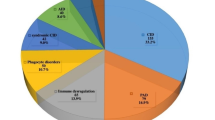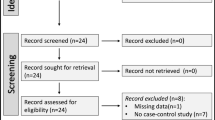Abstract
Introduction
Patients with primary immunodeficiency (PID) often report fatigue, yet this symptom has not been studied in PID. Fatigue affects 6–7.5% of healthy adults. The goal of this study is to estimate the prevalence of fatigue in patients with PID and investigate its associated factors.
Methods
We analyzed 2537 PID patients registered in USIDNET to determine responses to the field “fatigue” in the core registry form. Demographics, immune phenotypes, and comorbid conditions were compared between fatigued and non-fatigued patients to identify relevant associations and potential drivers. A focused analysis was performed for patients with predominantly antibody deficiency disorders (PADs).
Results
Fatigue was reported in 25.9% (95% CI 23.7–28.3) of PAD patients, compared to 6.4% (95% CI 4.9–8.2) of non-PAD. Patients with common variable immunodeficiency (CVID) had the highest prevalence of fatigue (p < 0.001) among all PID diagnoses. Other factors that were associated with a higher rate of fatigue among PAD patients included female sex, higher BMI, depression, bronchiectasis, and autoimmunity. Additionally, fatigued PAD patients had lower absolute lymphocyte, CD3, CD4, and CD8 counts compared to non-fatigued patients.
Conclusion
Our findings suggest that fatigue is overrepresented in PAD patients. Prospective studies to estimate prevalence, risk factors, and fatigue etiology in PID are warranted, so therapeutic interventions can be considered.




Similar content being viewed by others
Abbreviations
- PID:
-
Primary immune deficiency disorder
- PAD:
-
primary antibody deficiency
- QoL:
-
quality of life
- USIDnet:
-
US Immunodeficiency Network
- CVID:
-
common variable immunodeficiency
- DGS:
-
DiGeorge syndrome
- MAS:
-
miscellaneous antibody deficiency
- AGAMMA:
-
agammaglobulinemia
- CGD:
-
chronic granulomatous disease
- SCID:
-
severe combined immunodeficiency disorder
- ALPS:
-
autoimmune lymphoproliferative syndrome
- APCED:
-
autoimmune polyendocrinopathy with candidiasis and ectodermal dystrophy
- IPEX:
-
immune dysregulation, polyendocrinopathy, enteropathy X-linked
- HIGM:
-
hyperIgM syndrome
- ALC:
-
Absolute lymphocyte count
- IgG:
-
immunoglobulin G
- IVIG:
-
intravenous immunoglobulin G
- SCIG:
-
subcutaneous immunoglobulin G
- IBD:
-
inflammatory bowel disease
- IDF:
-
immune deficiency foundation
- TNF:
-
tumor necrosis factor
- STAT:
-
signal transducer and activator of transcription
- BMI:
-
body mass index
- CFS:
-
chronic fatigue syndrome
References
Bonilla FA, et al. Practice parameter for the diagnosis and management of primary immunodeficiency. J Allergy Clin Immunol. 2015;136(5):1186–205. e78
Bousfiha A, et al. The 2015 IUIS Phenotypic Classification for Primary Immunodeficiencies. J Clin Immunol. 2015;35(8):727–38.
Bousfiha AA, et al. Primary immunodeficiency diseases worldwide: more common than generally thought. J Clin Immunol. 2013;33(1):1–7.
Kobrynski L, Powell RW, Bowen S. Prevalence and morbidity of primary immunodeficiency diseases, United States 2001-2007. J Clin Immunol. 2014;34(8):954–61.
Busse PJ, Razvi S, Cunningham-Rundles C. Efficacy of intravenous immunoglobulin in the prevention of pneumonia in patients with common variable immunodeficiency. J Allergy Clin Immunol. 2002;109(6):1001–4.
Orange JS, et al. Use of intravenous immunoglobulin in human disease: a review of evidence by members of the Primary Immunodeficiency Committee of the American Academy of Allergy, Asthma and Immunology. J Allergy Clin Immunol. 2006;117(4 Suppl):S525–53.
Roifman CM, et al. Benefit of intravenous IgG replacement in hypogammaglobulinemic patients with chronic sinopulmonary disease. Am J Med. 1985;79(2):171–4.
Jiang F, Torgerson TR, Ayars AG. Health-related quality of life in patients with primary immunodeficiency disease. Allergy Asthma Clin Immunol. 2015;11:27.
Efficace F, et al. Chronic fatigue is the most important factor limiting health-related quality of life of chronic myeloid leukemia patients treated with imatinib. Leukemia. 2013;27(7):1511–9.
Efficace F, et al. Prognostic value of self-reported fatigue on overall survival in patients with myelodysplastic syndromes: a multicentre, prospective, observational, cohort study. Lancet Oncol. 2015;16(15):1506–14.
Gripp S, et al. Survival prediction in terminally ill cancer patients by clinical estimates, laboratory tests, and self-rated anxiety and depression. J Clin Oncol. 2007;25(22):3313–20.
Fink AM, et al. Fatigue, inflammation, and projected mortality in heart failure. J Card Fail. 2012;18(9):711–6.
Moreh E, Jacobs JM, Stessman J. Fatigue, function, and mortality in older adults. J Gerontol A Biol Sci Med Sci. 2010;65(8):887–95.
Stridsman C, et al. Fatigue Affects Health Status and Predicts Mortality Among Subjects with COPD: Report from the Population-Based OLIN COPD Study. COPD. 2015;12(2):199–206.
Groenvold M, et al. Psychological distress and fatigue predicted recurrence and survival in primary breast cancer patients. Breast Cancer Res Treat. 2007;105(2):209–19.
USIDnet. from USIDNET.org. Available at: http://www.usidnet.org/.
Walker EA, Katon WJ, Jemelka RP. Psychiatric disorders and medical care utilization among people in the general population who report fatigue. J Gen Intern Med. 1993;8(8):436–40.
Afari N, Buchwald D. Chronic fatigue syndrome: a review. Am J Psychiatry. 2003;160(2):221–36.
Health, N.I.o.M. Major Depression Among Adults. 2010. Available from: http://www.nimh.nih.gov/health/statistics/prevalence/majordepression-among-adults.shtml.
Lawrie SM, et al. A population-based incidence study of chronic fatigue. Psychol Med. 1997;27(2):343–53.
Huang IC, et al. The relationships between fatigue, quality of life, and family impact among children with special health care needs. J Pediatr Psychol. 2013;38(7):722–31.
Rhee H. Relationships between physical symptoms and pubertal development. J Pediatr Health Care. 2005;19(2):95–103.
Rhee H, et al. Prevalence of recurrent physical symptoms in U.S. adolescents. Pediatr Nurs. 2005;31(4):314–9. 350
Varni JW, et al. The PedsQL in pediatric cancer: reliability and validity of the Pediatric Quality of Life Inventory Generic Core Scales, Multidimensional Fatigue Scale, and Cancer Module. Cancer. 2002a;94(7):2090–106.
Varni JW, Burwinkle TM, Szer IS. The PedsQL Multidimensional Fatigue Scale in pediatric rheumatology: reliability and validity. J Rheumatol. 2004;31(12):2494–500.
Varni JW, et al. The PedsQL in pediatric rheumatology: reliability, validity, and responsiveness of the Pediatric Quality of Life Inventory Generic Core Scales and Rheumatology Module. Arthritis Rheum. 2002b;46(3):714–25.
Kanani A, Schellenberg R, Stark D. A pilot study of quality of life, mood, sleepiness and fatigue in patients with primary immunodeficiency receiving IVIG. Journal of Allergy and Clinical Immunology. 2007;119(1):S251.
Misbah S, et al. Subcutaneous immunoglobulin: opportunities and outlook. Clin Exp Immunol. 2009;158(Suppl 1):51–9.
Berger M. Subcutaneous administration of IgG. Immunol Allergy Clin North Am. 2008;28(4):779–802. viii
Foundation, I.D. Treatment Experiences and Preferences of Patients with Primary Immune Deficiency Diseases: First National Survey. 2003. Available from: https://primaryimmune.org/wp-content/uploads/2011/04/Treatment-Experiences-and-Preferences-of-Patients-with-Primary-Immune-Deficiency-Disease-First-National-Survey-2002.pdf. Cited 23 March 2015
Kerr J, et al. Is dosing of therapeutic immunoglobulins optimal? A review of a three-decade long debate in europe. Front Immunol. 2014;5:629.
Abolhassani H, et al. Home-based subcutaneous immunoglobulin versus hospital-based intravenous immunoglobulin in treatment of primary antibody deficiencies: systematic review and meta analysis. J Clin Immunol. 2012;32(6):1180–92.
Rojavin MA, Hubsch A, Lawo JP. Quantitative Evidence of Wear-Off Effect at the End of the Intravenous IgG (IVIG) Dosing Cycle in Primary Immunodeficiency. J Clin Immunol. 2016;36(3):210–9.
Quality., C.f.B.H.S.a. Behavioral health trends in the United States: Results from the 2014 National Survey on Drug Use and Health. (HHS Publication No. SMA 15-4927, NSDUH Series H-50). 2015.
Leone SS. A disabling combination: fatigue and depression. Br J Psychiatry. 2010;197(2):86–7.
Parker AJ, Wessely S, Cleare AJ. The neuroendocrinology of chronic fatigue syndrome and fibromyalgia. Psychol Med. 2001;31(8):1331–45.
Hickie I, Kirk K, Martin N. Unique genetic and environmental determinants of prolonged fatigue: a twin study. Psychol Med. 1999;29(2):259–68.
Harvey SB, et al. The relationship between fatigue and psychiatric disorders: evidence for the concept of neurasthenia. J Psychosom Res. 2009;66(5):445–54.
Yeh EA. Fatigue in childhood multiple sclerosis. Dev Med Child Neurol. 2016;58(3):218.
Mahieu MA, et al. Fatigue, patient reported outcomes, and objective measurement of physical activity in systemic lupus erythematosus. Lupus. 2016.
Jones EA. Fatigue complicating chronic liver disease. Metab Brain Dis. 2004;19(3-4):421–9.
Minnock P, et al. Perceptions of the Cause, Impact and Management of Persistent Fatigue in Patients with Rheumatoid Arthritis Following Tumour Necrosing Factor Inhibition Therapy. Musculoskeletal Care. 2016.
Barroso J, et al. Fatigue in HIV-Infected People: A Three-Year Observational Study. J Pain Symptom Manage. 2015;50(1):69–79.
Swain MG. Fatigue in chronic disease. Clin Sci (Lond). 2000;99(1):1–8.
van't Leven M, et al. Fatigue and chronic fatigue syndrome-like complaints in the general population. Eur J Public Health. 2010;20(3):251–7.
NIH. Unexplained Fatigue in Elderly. 2007.
Furberg H, et al. The prevalence of self-reported chronic fatigue in a U.S. twin registry. J Psychosom Res. 2005;59(5):283–90.
Dinos S, et al. A systematic review of chronic fatigue, its syndromes and ethnicity: prevalence, severity, co-morbidity and coping. Int J Epidemiol. 2009;38(6):1554–70.
Jason LA, et al. A community-based study of chronic fatigue syndrome. Arch Intern Med. 1999;159(18):2129–37.
Song S, Jason LA, Taylor RR. The Relationship Between Ethnicity and Fatigue in a Community-Based Sample. Journal of Gender, Culture and Health. 1999;4(4):255–68.
Vgontzas AN, Bixler EO, Chrousos GP. Obesity-related sleepiness and fatigue: the role of the stress system and cytokines. Ann N Y Acad Sci. 2006;1083:329–44.
Flores S, et al. Examining the impact of obesity on individuals with chronic fatigue syndrome. Workplace Health Saf. 2013;61(7):299–307.
Das UN. Is obesity an inflammatory condition? Nutrition. 2001;17(11-12):953–66.
Vgontzas AN, et al. Elevation of plasma cytokines in disorders of excessive daytime sleepiness: role of sleep disturbance and obesity. J Clin Endocrinol Metab. 1997;82(5):1313–6.
Lim W, et al. The association of obesity, cytokine levels, and depressive symptoms with diverse measures of fatigue in healthy subjects. Arch Intern Med. 2005;165(8):910–5.
Fukuda K, et al. The chronic fatigue syndrome: a comprehensive approach to its definition and study. International Chronic Fatigue Syndrome Study Group. Ann Intern Med. 1994;121(12):953–9.
Echteld MA, et al. Multidimensional fatigue and its correlates in hospitalised advanced cancer patients. Eur J Cancer. 2007;43(6):1030–6.
Stauder MC, et al. Overall survival and self-reported fatigue in patients with esophageal cancer. Support Care Cancer. 2013;21(2):511–9.
McCabe RM, et al. Fatigue as a Driver of Overall Quality of Life in Cancer Patients. PLoS One. 2015;10(6):e0130023.
Flensner G, et al. Fatigue in relation to perceived health: people with multiple sclerosis compared with people in the general population. Scand J Caring Sci. 2008;22(3):391–400.
Seeborg FO, et al. Perceived Health in Patients with Primary Immune Deficiency. J Clin Immunol. 2015;35(7):638–50.
Covinsky KE, et al. Health status versus quality of life in older patients: does the distinction matter? Am J Med. 1999;106(4):435–40.
Efficace F, et al. Patient- versus physician-reporting of symptoms and health status in chronic myeloid leukemia. Haematologica. 2014;99(4):788–93.
Skeath P, et al. The nature of life-transforming changes among cancer survivors. Qual Health Res. 2013;23(9):1155–67.
Masten AS, Coatsworth JD. The development of competence in favorable and unfavorable environments. Lessons from research on successful children. Am Psychol. 1998;53(2):205–20.
Watkins ER. Constructive and unconstructive repetitive thought. Psychol Bull. 2008;134(2):163–206.
Acknowledgments
We grateful acknowledge Ms. Marla Goldsmith USIDNET Registry Manager and Tara Caulder Project Director for their expertise, dedication and support through every step of this project.
Author information
Authors and Affiliations
Corresponding author
Ethics declarations
Conflict of Interest
The authors declare that they have no conflict of interest.
Rights and permissions
About this article
Cite this article
Hajjar, J., Guffey, D., Minard, C.G. et al. Increased Incidence of Fatigue in Patients with Primary Immunodeficiency Disorders: Prevalence and Associations Within the US Immunodeficiency Network Registry. J Clin Immunol 37, 153–165 (2017). https://doi.org/10.1007/s10875-016-0367-1
Received:
Accepted:
Published:
Issue Date:
DOI: https://doi.org/10.1007/s10875-016-0367-1




